► Aston Martin DB12 unveiled
► ‘Beyond GT to Super Tourer’
► Out goes V12, V8 only, £185k
The new Aston Martin DB12 is the latest offspring of the DB bloodline, the grand tourer branch of the family tree that’s marking its 75th anniversary this year. The successor to the DB11 will arrive in showrooms in the third quarter of 2023, priced from around £185,000.
It’s a major overhaul of the DB11, rather than all-new – but don’t dismiss this as a light makeover. There are significant changes to engine outputs, chassis hardware and a brand spanking new interior to address many of its predecessor’s shortcomings. It’s not been given the new DB12 badge for nothing. Find out more in our video above, as CAR magazine is given an exclusive backstage tour of the car by Aston Martin Lagonda design director Miles Nurnberger.
The 2023 DB12 ushers in the next generation of Aston Martin sports cars: vehicles developed under new chairman Lawrence Stroll and the growing influence of the Geely group, which last week doubled its stake to 17%.
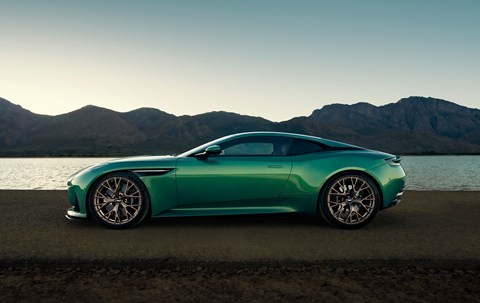
Note how the newcomer fuses classical styling and traditional sports car engineering with a new digital heart; this is the first Aston to qualify as a connected car and the DB12 ushers in the company’s all-new infotainment system boasting over-the-air updates, apps and remote services for the first time.
That’s right: this isn’t your usual Aston Martin…
Aston Martin DB12: the engineering specs
Based upon the latest iteration of the familiar lightweight Aston architecture, the DB12 is heavy on its use of aluminium, including pressings and extrusions bonded together to save weight and increase strength. Special attention has been paid to the stiffness of the structure, which is said to be 7% more rigid than the DB11 (the better for handling, refinement and durability).
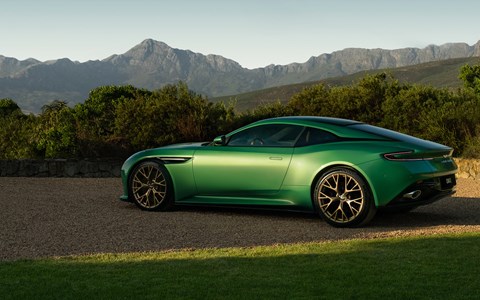
Interestingly, the car is a smidge shorter and narrower than the outgoing DB11; a rare feat in this day and age, when bloat is the norm, rather than the exception. Not that the 1685kg kerbweight qualifies the DB12 as a true lightweight (especially since it’s quoted dry, without 100 or so kilos of fuels and lubricants).
Drive is again sent to the rear transaxle via a carbonfibre propshaft, the eight-speed automatic slung out back for a 48:52 front:rear weight distribution to the benefit of handling balance. Expect a dynamic leap forwards, as Aston Martin has overhauled the front wishbones and multi-link rear suspension with new adaptive Bilstein DTX adaptive dampers whose bandwidth has increased fivefold. Result? Wider parameters of comfort and sportiness with a choice of GT, Sport, Sport+, Wet and Individual modes.
AMG’s V8 uncorked
The V12 option is quietly dropped from the DB12, leaving just Daimler’s 4.0-litre V8. It’s the Mercedes-AMG unit recently discontinued in the C63, but earlier diktats inked in Stuttgart that the British application could not stretch the parameters of power are well and truly rescinded. Here the twin-turbo lump produces a brawny 590lb ft of torque (up a third on the outgoing DB11) all the way from 2750-6000rpm, the same peak revs as maximum power of 671bhp.
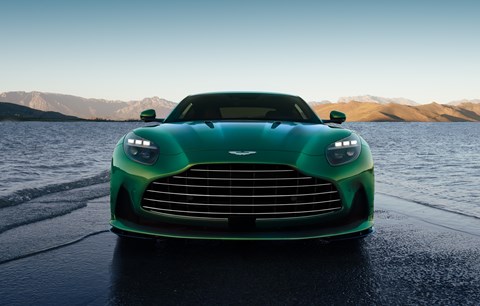
As those numbers suggest, the DB12 will be no slouch: sixty is dispatched in 3.5sec (gotta love the Imperial 0-60mph; Europe’s 0-62mph takes a tenth longer) and v-max is rated at 202mph. That extra performance is credited to larger-diameter turbos, reprofiled cams and other detailed tuning to the AMG engine. Engineering sources confirm there is room for hybridisation in the coming years.
It’s a significant step up in power, necessitating greater thermal management. That swollen Aston grille feeds radiators hungry for cooling air; Aston claims a 56% increase in the surface area of open apertures (not a 56% bigger grille), necessary to manage the thermal needs of the seriously thuggish 4.0-litre V8, which is mounted so far back in the engine bay that the company calls it ‘front mid-mounted.’
Is it still a 2+2?
It certainly is. The basic footprint of the DB12 echoes that of the DB11 and the rear structure is all but identical. A pair of tiny +2 rear seats are mostly used by owners to transport children, carry luggage or – occasionally – take grown-ups for short runs back from the pub or around town.
Bootspace is a decent 262 litres and the luggage compartment is a surprisingly commodious affair. This is a grand tourer into which you really can sling all your bags for a weekend away.
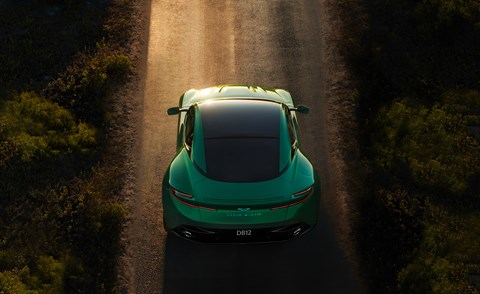
So improved are the DB12’s abilities, according to Aston Martin, that it says the car transcends traditional Grand Tourer status to become ‘the world’s first Super Tourer.’ A bold claim or mere marketing hogwash? You decide…
Will the Aston Martin DB12 be a bit of a handful with 671bhp through the rear wheels?
As we haven’t yet driven the DB12, we don’t really know the answer – but Aston’s certainly throwing the kitchen sink at the rear axle to keep it under control.
The new Bilstein adaptive dampers, world debut of Michelin’s quieter Pilot Sport 5 (275/35 ZR21 up front, 325/30 ZR21 at the back) and Aston’s first active rear differential suggest an overhaul of the car’s dynamic capabilities. The diff can switch from open to fully locked in milliseconds and the ESP stability control is reprogrammed for faster, more imperceptible interventions.
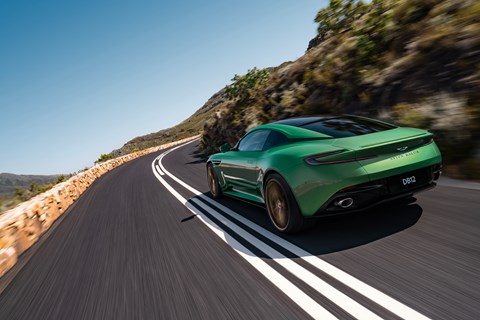
Aston Martin knows how to make sports cars handle deftly and the evidence points to the DB12 having the dynamic chops to keep that reputation intact. Where it has struggled in recent years as a solo player is in the digital sphere. Anyone who’s wrestled with the hand-me-down Volvo and Mercedes infotainment systems from the past two decades will know that cutting-edge cabin controls are damned hard to pull off. The interior plays witness to the biggest change of all.
A new interior and bespoke Aston Martin infotainment
Out go dated Merc Comand systems in favour of Aston Martin’s first inhouse set-up. We’ve had a quick play and can confirm that the user experience, logic and design are simple and effective. Most welcome of all is how they’ve layered the tech unobtrusively in the background: the screen is a modest 10.25 inches in diameter, so it doesn’t overpower the leatherbound luxury of the cabin.

The touchscreen is claimed to offer the sharpest resolution on the market with a 1970-pixel definition and 30-millisecond response time. Wisely, Aston Martin has stuck with physical controls for ventilation and most minor switchgear.
‘The brief was cleanliness and simplicity of use,’ Nurnberger tells CAR. ‘It’s all about how we layer technology in the car: for instance, we definitely didn’t want to put heating controls on a touchscreen. There are certain functions drivers just need to do instantly. We wanted to remove the “piss-off” factors. You wouldn’t believe the conversations we had about whether to keep the physical electric seat controls, for instance. Late in the day, we decided to keep them.’
The first connected Aston Martin
With its own SIM card and data hook-up, the DB12 is the first connected car from Aston – allowing a host of digital services and functions. Just let that sink in for a moment: one of Britain’s oldest, most storied and most analogue car brands has now plugged into the internet of things. It’s a huge step forward, demanded by rapidly changing customer expectations, according to Nurnberger.
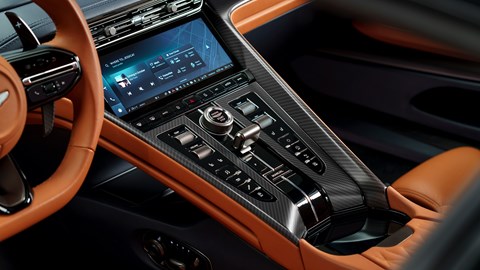
‘The trend for more digital touchpoints in interiors started a decade ago, but in the past five years the pace of change became more rapid,’ he explains. ‘We took a key decision three years ago to rethink our approach to interior design and technology… We were up there for exterior design, but we did not have the resources or capabilities to get the interiors as good as they needed to be. It had become a pain point for us.’
Hence the major leap forwards in the Aston Martin DB12 interior. It’s all change. You can track your car’s whereabouts from your phone, examine trip data and benefit from over-the-air updates bringing new functionality to the car over its lifecycle.
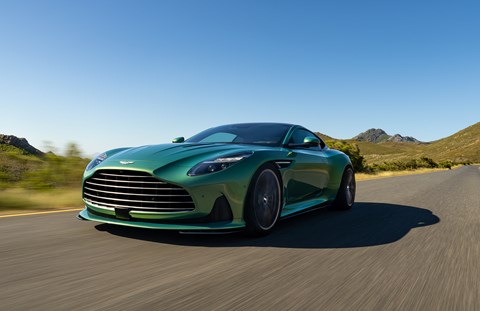
The Aston Martin app is a new product from Gaydon and three years’ subscription is included from purchase; after that you will have to pay an annual fee for services, tiered into convenience, vehicle management and vehicle services packages.
The new infotainment system will be plugged into a high-end 15-speaker, double amplified 1,170W surround sound system from Bowers & Wilkins, and Gaydon has revealed B&W’s inclusion in the all-new DB12 is the first chapter of a new partnership between the two brands.

Verdict
The new 2023 Aston Martin DB12 is a shrewd update of a heartland car for the brand. On this first evidence, they’ve focused the changes on the areas that most needed updating – while keeping the sophisticated sporting aesthetic and dynamic capabilities intact.
It’s a delicate balancing act. If Aston can pull it off, they might just have polished the style, boosted the performance and removed the annoyances of the interior that sent some buyers towards rival brands.
Watch this space in the coming weeks for our new Aston Martin DB12 review…